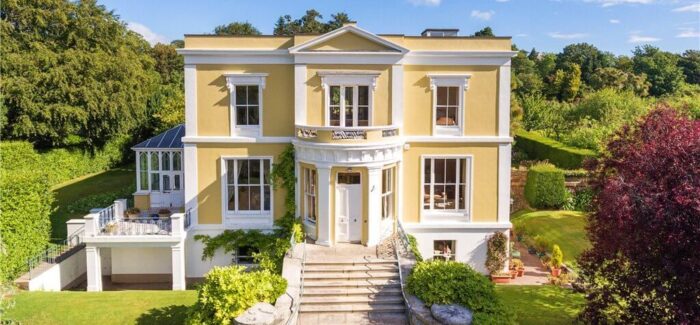Montebello
| Name | Montebello |
|---|---|
| Address | Killiney Hill Road |
| Year Built | 1860 |
| Architect | John Skipton Mulvany |
| Exists today | Yes |
| On 1888 map | Yes |
Introduction
We are grateful to Tony Plunkett who has contributed this specially written piece on his family connection to Montebello which spans the period from 1868 to 1918. This very comprehensive and well researched history of the Kirkwood links to Killiney illuminates an era long since vanished and the lifestyles of the families who lived in the large houses of Killiney in changing times. Read more about Tony’s relationship and interest in the Kirkwood family at the end of this article.
Montebello & the Kirkwood Connection by Tony Plunkett April 2023
‘Montebello House’ was offered for sale by auction as either one or two lots on 17 September 1868. Brassington & Geale – scattering capital letters with abandon – advertised the property as ‘a Modern Mansion House standing on more than three acres,’ describing it as ‘of handsome design, suitable for a Nobleman or Gentleman [with] all recent Architectural Improvements and a never-failing supply of Water from a Well 90 feet deep. Ornamentally planted grounds [offer] extended views of Dublin Bay, Bray Head and the Wicklow Mountains’. The second lot consisted of a further three-plus acres adjoining lot one, ‘to which it would be invaluable as a cow park.’
The successful bid was made by a 53 year old merchant from Killala, Co. Mayo, named Joseph Kirkwood. Whilst continuing to maintain his home town affiliations, he had become a regular visitor to Dublin during the 1850s and 60s. He stayed frequently at the Royal Hibernian Hotel, according to the Dublin press, which detailed the comings and goings of the ‘great and the good’. His bid was the start of an almost 50 year connection with ‘Montebello’ for the Kirkwood family.
LAND & PROPERTY AGENT
As a successful land agent from a gentry family, Joseph, a magistrate like his father, had built up his holdings in his home area. An indication of his financial standing according to Griffiths Valuation of Ireland, (the first full scale valuation of property in Ireland, undertaken between the years 1847 – 1864, to determine liability to pay the Poor Rate) showed Joseph Kirkwood to have owned or leased property in and around Killala, with a total annual valuation in excess of £350. Furthermore, on two occasions during 1853, he made major land purchases via the Encumbered Estates’ Court, (set up to facilitate the sale of those Irish estates whose owners were unable to meet their obligations following the Great Famine of the 1840s) One purchase was in Ballyglass, the other in Kinaffe and Knockbrack. Taken together, the sale amounted to £5,030, a sum later confirmed in Allnut’s Irish Land Schedules. It was also around this time (March 1855), that Joseph Kirkwood Esq., already the owner of a 12 ton ‘cutter yacht,’ was listed amongst a select number of gentlemen admitted to the Royal Western Yacht Club, Ireland.
In addition to his business interests as a landlord and his responsibilities as a local magistrate, Joseph also involved himself in the town’s wider issues eg the Poor Law Union Commissioners and workhouse affairs; attending meetings concerning a possible extension of the Great Northern and Western Railway to Ballina; and contributing to a fund for the relief of Killala fishermen during a period of particularly hard times, suggesting how the money might be best deployed and indicating a readiness to make further contribution should the distress among ‘my fellow townsmen prove more than temporary’.
MARRIED LIFE IN DUBLIN

Some nine years prior to the ‘Montebello’ purchase, Kirkwood married Harriett Amelia, 25 year old daughter of Henry Biddulph Warner J.P., of Marvelstown, Co. Meath. Their wedding took place on 10 September 1859, at St. Ann’s Church, Dawson Street, Dublin. As might be expected, numbers in the Kirkwood family began to increase, but so it seemed did their acquisition of Dublin properties. Indeed, a communication dated 21 February 1861, sent by Joseph, to his local newspaper, the ‘Mayo Constitution’, bore the Dublin address, ‘Mount Erroll’ in Donnybrook. [a property currently classified as a ‘protected structure’] Some seven months later, Joseph advertised the sale of the lease for that same house, ‘a 14 room property standing on six acres.’ The Thoms ‘Directory of Dublin’, which published each year details of local rate payers by residence, listed Kirkwood in both 1861 and 1862 at Mount Erroll, Donnybrook, and at Rathfarnham in 1865, whilst his wife Harriett, was listed under her own name, in Thoms 1862, at 4 Somerset Place, Raglan Road and again from 1864 – 1867 at 21 Leeson Park Road, both in Dublin. Indeed their first two children were born at Mount Erroll, the third at 44 St Stephen’s Green in 1862; and the fourth at ‘Highfield’, Rathfarnham in 1864 – all Dublin addresses.
There was perhaps some brief relief during this ‘moving-around-Dublin’ period, as the family was observed to have taken a continental break, when on 30 May 1862, local press reported that ‘Mr & Mrs Joseph Kirkwood, family and suite have arrived at the Hibernian Hotel from Italy’. However, the family was to experience deep personal tragedy some two years later, with the sudden deaths of two of their four children. Eldest child, Harriett, then five years old, and Evaline, about six months old, both passed away during the month of January 1865. Notwithstanding this tragic occurrence, life for the remaining family moved on and another daughter, Henrietta, was born in September 1869 at ‘Montebello’, Killiney.
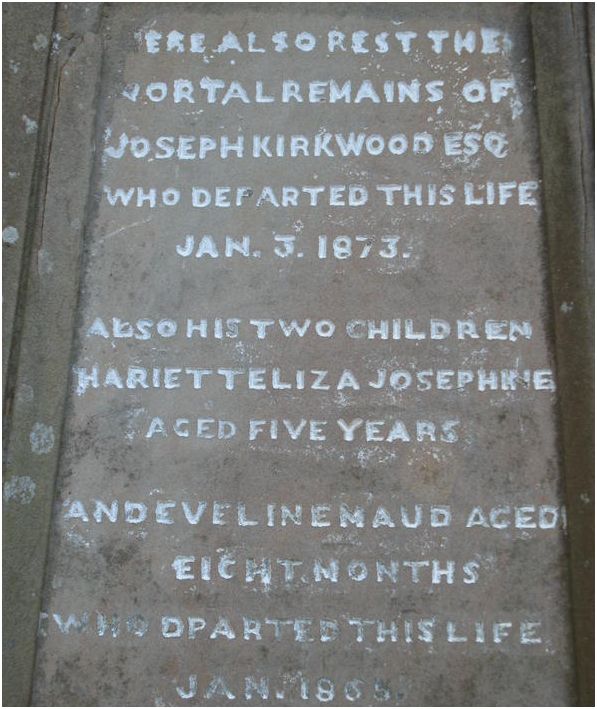
Joseph Kirkwood himself died at ‘Montebello’ on 4 January 1873. In his obituary he was described as ‘an active and impartial magistrate and an excellent resident landlord. A most gentlemanly and humane man, a good friend and neighbour who was much and deservedly respected by all classes of the population by whom his death is lamented.’ His will, which was re-sworn in January 1878 – five years after his death – was thus eventually valued at ‘under £8,000.’ His gravestone in Killala bears the inscription, ‘Here also rest the mortal remains of Joseph Kirkwood Esq. who departed this life Jan. 3 [sic] 1873. Also his two children Harriett Eliza Josephine aged five years and Eveline Maud aged eight months, who departed this life Jan, 1865’
MERRY WIDOW
As things turned out, Harriett did not remain a widow for long. On 27 August 1874, she married the Hon. Charles Dawson Plunkett, a 63 year-old ex Army Officer. Their wedding took place at 5, Pembroke Place, Blackrock, by special licence granted by the Archbishop of Dublin. Since his retirement from the regiment in 1868, and prior to his marriage six years later, the Major General had been living in London at Carlton Chambers, 8, Regent Street. Born in 1811 at Louth Hall, in Co. Louth, Charles Dawson Plunkett joined the 1st Royal Regiment as an Ensign in October 1833. His active service included the Crimean Campaign of 1854-55, and he gained promotions through the ranks to Lieutenant Colonel. He retired on full-pay and was granted the honorary rank of Major General on 18 November 1868, after more than thirty years service. Earlier in August that year, the Army and Navy Gazette reported that the currently ‘vacant’ good service pension of £100 per year, had been given to Colonel Hon. C D Plunkett, then commanding the 1st Battalion of the Royals. Basing himself in London was also convenient for attending occasional military related functions. For example he was among 200 noblemen and gentlemen presented to HM Queen at Her Majesty’s Levee held at St James Palace on his return from India (Date? 1860S?)
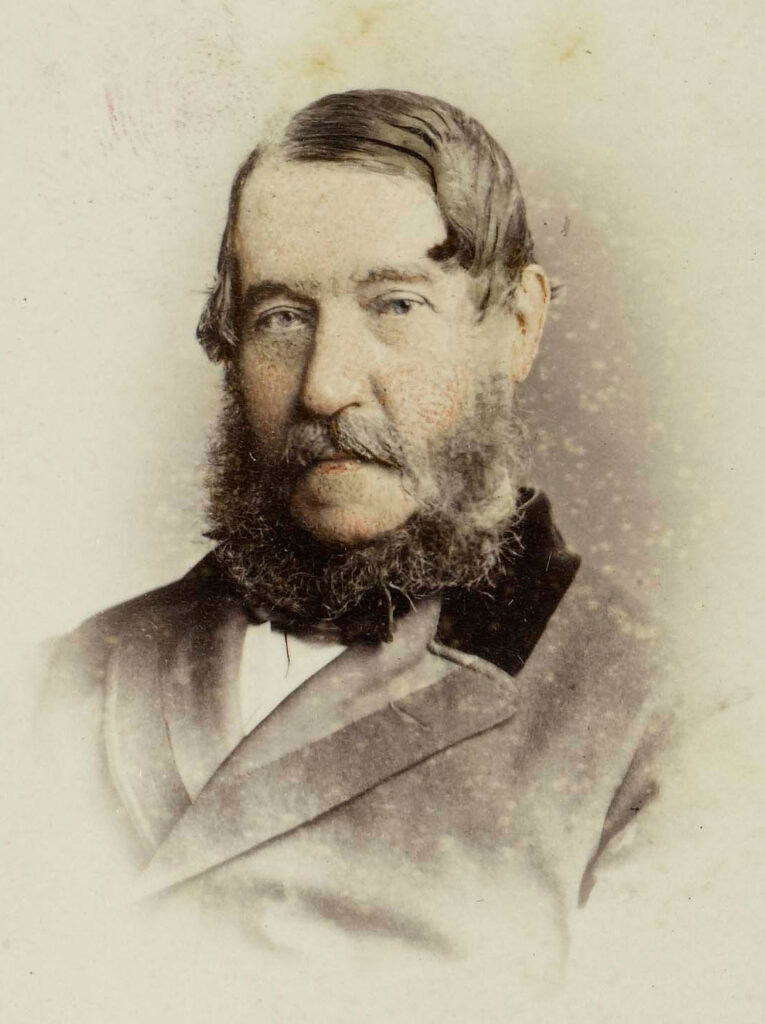
The couple settled to married life in ‘Montebello’ along with Harriett’s three surviving daughters from her first marriage. Their ages at that point ranged between 5 and 13 years. However, the newly married couple lost little time in producing a child of their own, yet another girl. Anna Georgina Constance Plunkett was born on 4 June 1875. Harriett’s second marriage also brought with it a title and position which elevated her on occasions into Dublin’s more rarefied social circles. For example, in February 1876, Harriett and her husband were amongst the guests who had the honour of receiving an invitation from His Grace, the Duke of Abercorn, Lord Lieutenant of Ireland, to a dinner party, at the first, ‘Drawing Room’ of the season at Dublin Castle,
But in August that year, Harriett was involved in an unfortunate incident in a jeweller’s shop in Dublin, involving two rings which were wedding gifts from her new husband. It developed into a court action and potentially unwelcome publicity in the newspaper columns, not only at the time the incident was first reported, but again almost five years later in February 1880, when the case finally came to court! In brief, the case involved an action for alleged breach of contract and for alleged slander. The defendant was Henry K White, a jeweller in Grafton Street, Dublin. The case of the plaintiff, Hon. Mrs Plunkett, was that she purchased certain diamonds from the defendant to be set in her two rings, but afterwards found that the diamonds were not the quality the defendant warranted them to be. Further, that one of the diamonds, having been unskilfully set, dropped out and was lost. Mrs Plunkett sent back one of the diamonds and refused to pay for it and the slanderous words objected to were that the defendant, Henry K White said that Mrs Plunkett had sent back a different stone from that which had been supplied.
Whilst many column inches were devoted to the case by the press during the hearing, the actual verdict of one paper was brief. It simply stated that ‘in the diamond case, Plunkett v. White, the jury, disregarding the alleged slander and libel on either side, awarded the plaintiffs £33 damages as the estimate of the excess charged for the diamonds supplied by the defendant.’
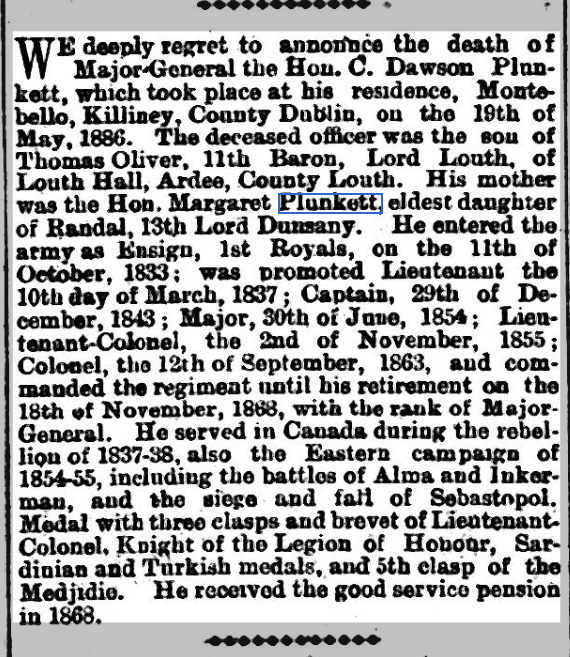
Harriett’s new husband fared no better in a separate court case he pursued around the same time. He sought a sum of £50 damages for breach of a contract originally drawn up on 3 November 1876 with a contracting builder, John Harvey, of Ballybrack. For the plaintiff it was argued that substantial damage was shown to have been done based on an inspection of the work which brought about the action. The defence argued that the plaintiff had made no complaints for many months and it would be unreasonable to be held responsible for damage possibly caused later by painters who were subsequently on site. The Dublin Evening Mail of 6 April 1978, reported that His worship decided that he could not hold the defendant responsible for all the damage and awarded a decree of £5!
Apart from that court action, the Major General generally maintained a low profile, deliberately or otherwise, certainly so far as press publicity was concerned, other than the occasional invitation to a function connected with his previous military connections. He died suddenly as a result of cardiovascular problems at ‘Montebello’ in May 1886. He was aged 75. He left £5,700 plus £491 in England. He was buried at Deansgrange Cemetery but perhaps surprisingly, there seems to have been no press publicity surrounding his funeral. Perhaps that was how he wanted it.
A SOCIAL LIFE
Despite the sad loss of her second husband, Harriett, still only in her early fifties, was able to maintain a social life for herself and her daughters. Around the time of her husband’s death, Freeman’s Journal (25 February1886) reported that ‘Miss Amy Kirkwood and Miss Kathleen Kirkwood, introduced by Hon. Mrs Plunkett’, attended a ‘Drawing Room’ function at Dublin Castle. Four years later, the youngest Kirkwood daughter, Henrietta, attended a similar function along with her mother.
Also that year (1890) the Hon. Mrs Plunkett of Montebello, Killiney, was listed among committee members from whom tickets (6 shillings each) could be purchased for ‘The Second Floral Dance’, (President: Her Serene Highness, Princess Edward of Saxe-Weimar) at Leinster Hall, Molesworth Street, Dublin to be held on Tuesday 27 May from 9pm. She also hosted occasional private events at ‘Montebello.’ The publication, Irish Society Dublin, reported in May 1891 that ‘The Hon. Mrs Plunkett gave a pleasant afternoon party at her picturesque residence, Montebello, Killiney on Saturday last, when a large number of guests appeared in answer to the hostess’s invitation, music being one of the attractions’ The following year, September 1892, the same publication was able to report that The Hon. Mrs Plunkett’s dance at her residence near Killiney ‘proved pleasant in the extreme. Her pretty house looked prettier then ever, decked with flowering shrubs and rare blossoms arranged with taste in every available spot. Dancing was kept up until a late hour to the strains of Liddell’s Viceregal Band.’
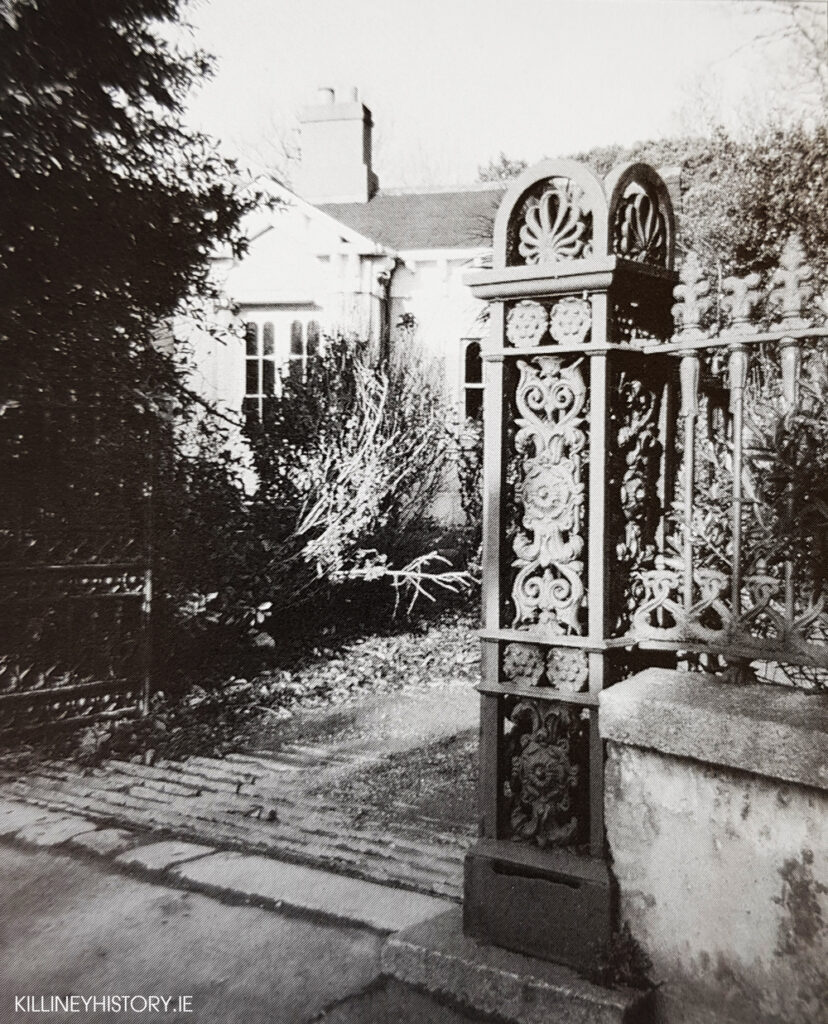
However, landlord responsibilities, inherited as a result of her first husband’s will continued to present problems. Those renting out land and property were accustomed to using the legal system of the Petty Sessions Court, to seek redress against clients for persistent rent arrears, illegal occupation etc. Harriett was singled out for adverse press criticism concerning one such dispute in respect of a property in Kinaffin, County Mayo. In the Western Mail, a communication dated 1 November 1890 stated, ‘The Hon. Mrs Plunkett’s tenants demand an abatement of 6s in the £ on their rents and the reinstatement of [a tenant] Mrs Cunniffe. ‘How her ladyship will appreciate the ultimatum of a people for whom on her own showing, she has done so much, remains to be seen. A threatening letter with the Montebello postmark will hardly threaten them into surrender, or a pharisaical wail of ingratitude into compliance with her ladyship’s request for the full pound of flesh.’ Earlier, in April that same year, Michael Cunniffe was found guilty of an action brought by Harriett and her three daughters, for unlawful and forcible possession of a dwelling house. He was convicted and ordered to be ‘imprisoned in H.M.Prison at Castlebar for three calendar months with hard labour.’
Harriett survived her second husband by a further seven years. A notice appeared in the press on 16 February 1893, stating, ‘The Louth Family are placed in mourning by the death of the Hon. Mrs Plunkett … a most popular member of society and will be much missed among a large circle of friends.’ Her funeral took place from her late residence, Montebello, Killiney and she was interred at Deans Grange Cemetery. The chief mourners included Lord Louth, Colonel Johnston [husband of Hon. Augusta Plunkett], Thomas A. Farrell [husband of Hon. Randalina Plunkett], Merrick Shawe Plunkett of Rhyl, North Wales and Major William Nangle [nephew of the deceased Hon. Mrs Plunkett.]
Under the terms of her will, Harriett’s three Kirkwood daughters, Amelia, Kathleen and Henrietta, were entitled to share their mother’s jointure of £2,000 from her first husband, and because they had been further provided for by their late father, Harriett left her ‘interest’ in Marvelstown Co. Meath, to her youngest daughter, Constance Plunkett. The residue of Harriett’s estate, amounting to almost £10,000, was left in equal shares to the four daughters. The executor named in Harriett’s will (W.W. Carruthers, solicitor who acted for the Kirkwoods in other legal matters, renounced probate, and administration was therefore granted to eldest daughter, Amelia.)
DAUGHTERS IN CHARGE
After their mother’s death, her daughters began to hold the occasional party at ‘Montebello’ and attend similar functions at the houses of friends. On 17 Nov 1894 the Social Review (subtitle, ‘The Leading Journal of Society & Fashion in Ireland) reported ‘upwards of 200 appreciative guests attended a very charming party, jointly hosted by Mrs Tufnell-Peacocke and Miss Clifford Lloyd at Killiney Castle. Among the throng, ‘Miss Plunkett of Killiney wore a cardinal silk blouse with bretelles [ornamental straps] of black attached to the skirt,’ whilst the Misses Kirkwood looked stylish in large picture hats.’ Three months later, on 2 Feb 1895 the Social Review was again on hand to report: ‘On Wednesday last, Montebello, Killiney was the scene of a very pretty and smart dance given by Miss Plunkett and the Misses Kirkwood. Messrs Coatts supplied the music and played merrily ’til 5 o’clock in the morning. There were over 40 young couples present, amongst whom were noted [lengthy list of names] The supper was excellent, the flowers magnificent and at this season of the year quite exceptional. Some of the officers of the garrison drove all the way back to Dublin in order to be back in time for the ‘Field’ day drill on Thursday morning. So it cannot be denied there are some very good and keen dancing men amongst the soldiers quartered in Dublin’.
The Social Revue was present again later that same year, to record that on Thursday 21 November, ‘Miss H Kirkwood of Montebello, Killiney, was one of three bridesmaids at the wedding of her friend, Miss Norah Peacocke, daughter of Captain Leslie Peacocke of Villagio, Dalkey, to Robert Gardner J.P. of Dublin’. [A Chartered Accountant, subsequently knighted in 1905] The marriage was solemnised at Dalkey Parish Church in the presence of a very large congregation. The bridesmaids wore handsome costumes of cream serge, trimmed with skunk, cream brocaded satin waistcoats and picture hats of white felt, trimmed with cream ostrich feathers and skunk tails. Each bridesmaid wore a gold bracelet set with pearls and turquoise and carried a shower bouquet of chrysanthemums, the gifts of the bridegroom.’
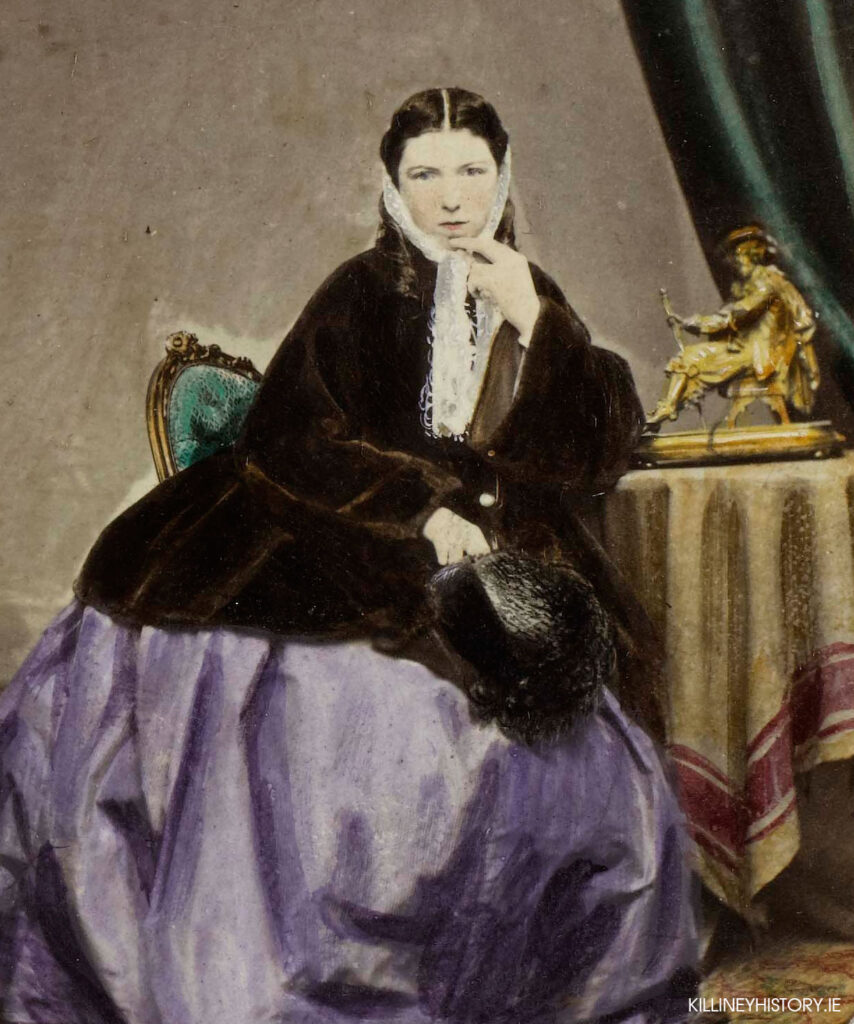
One assumes her step-sisters were also present on 19 April 1898, when Constance Plunkett, age 22, married Lionel Edmund Anstey Bennett in London. He was the son of a Clergyman from Castleroe, Coleraine, Co Londonderry. The marriage took place at St Peter’s Church, South Kensington, Constance giving her address on her marriage certificate as ‘Killiney, Co. Wicklow’. Some ten months later the couple had a child, Constance Evelyn, born in Tintern, Monmouthshire on 10 February 1899. Unfortunately, whilst the child thrived, new mother, Constance, passed away the following year in May 1900.
The 1901 Census of Ireland found the three Kirkwood sisters together at 46, St Stephen’s Green East, Dublin. Also resident were three domestic servants: a butler, maidservant and cook. (As previously stated Kathleen Margaret Kirkwood was born at 44 St Stephen’s Green, almost 40 years earlier in October 1862) However they were back at Montebello, according to the Weekly Irish Times on 29 August 1903, reporting that ‘The Misses Kirkwood had an agreeable outdoor party on Friday last week, a tennis tournament taking place in their highly picturesque grounds. The three hostesses, stylishly costumed, busied themselves in looking after the comfort and enjoyment of their guests. Beautiful flowers and fruit were features of the entertainment.’
LEGAL MATTERS
But evidence that the Kirkwood sisters were no longer residing permanently at ‘Montebello’ became apparent from an article in the Newry Reporter in November 1902, under the heading ‘A House and its Drains’. It referred to a court hearing in the case of Mr James N. Richardson against the Misses Kirkwood before the Lord Chief Baron. It was a claim for £100 by the plaintiff – James N. Richardson, Chairman of Bessbrook Spinning Company, Liberal politician and former M.P. for Armagh(1880-85) – for alleged breach of contract in respect of the letting of ‘Montebello’, Killiney for two months, and for money paid to the Kirkwoods, the defendants. Mr. Richardson alleged that the drains were in a defective condition and that he could not remain in the house. The defendants denied the existence of a contract and counterclaimed for £50, the balance of the rent which plaintiff agreed to pay for the house.
Mr Kaye Parry, for the plaintiff, stated that he had examined three thousand buildings in his experience as an architect and civil engineer. He considered that the smoke test the best to apply and he would not recommend any client of his to go into the house as it had been found by Mr. Ross, having regard to the result of that test. Sergeant Dodd, for the defence, said the defendants had done everything to the house that experts told them to do and had a certificate in 1901, that the house was in perfect sanitary condition. The house had been previously let to a Mr Percy Barnard in the summer months of 1901, and later occupied by Mr. Charles Martin.
The jury found that the house was reasonably fit for habitation when the plaintiff left it, and that the defendants had accepted a surrender from the plaintiff before the second month’s rent commenced to accrue due. The Lord Chief Baron said this amounted to a verdict for the defendants in the original action and for the plaintiff in the counter-claim. Judgement was entered accordingly.
Despite or because of their landlord responsibilities, it seems the Kirkwood trio were determined to take the occasional break. On 31 March 1906 the three Miss Kirkwoods (no initials recorded in the ship’s register) arrived at Liverpool from Tenerife on the s.s ‘Zania’, a British & African Steam Navigation Co. vessel. By coincidence, an informal letter to Lord Louth, dated May 1906 penned by Sir Arthur Vicars, Master at Arms, Dublin Castle, observed ‘I saw one of the Kirkwoods in Dublin so presume they are back from their tour.’ Perhaps the Louth/Kirkwood family connection, no doubt forged during their mother’s second marriage to Major General Plunkett, endured beyond her death. A surviving personal diary for the year 1900 kept by Lord Louth, contains an entry for December 24th : ”Henny’ Kirkwood and Kathleen Kirkwood came from Dublin by afternoon train’.)
In 1910 a notice appeared in the local press announcing the marriage on August 8th in Dublin, of ”Harry’ Somers Moorhead, son of Dr. Harry Moorhead J.P. Moate, Westmeath to Amelia Mary (Amy) second daughter of the late Joseph Kirkwood and step-daughter of the late General the Hon. Charles Dawson Plunkett, of Montebello, Killiney, Dublin.’ It is not clear whether Amy’s marriage was a significant factor in prompting her to reconsider the long standing arrangements under which she and her sisters jointly shared ownership of ‘Montebello’ along with other properties, but Amy made a firm move in this direction which prompted a legal action, known as ‘partition of real estate’ which would place the Kirkwood siblings on a serious collision course.
But before that the 1911 Census of Ireland conducted in April of that year had Kathleen Kirkwood as a ‘Visitor’ at the Royal Hibernian Hotel in Dublin but no trace of her two sisters. Amy’s husband, Henry Moorhead, married, age 25 was listed as a ‘Boarder’ and ‘Medical Student’, resident at 54 Rutland Square, Dublin.
PARTITION SUIT
However, about April 1912, Amelia Mary Kirkwood, now Mrs Moorhouse, instituted two actions in the Chancery Division against her sisters, Henrietta and Kathleen Kirkwood, for a partition suit, of lands in County Mayo, and of the [Montebello] premises in Killiney in one action and in the other, for the partition of lands in County Louth and premises in Dublin. According to an affidavit from Solicitor, Mr Charles Gamble, of Carruthers & Gamble, ‘the proposed defendant instructed his firm to act as her solicitors in the actions, and they did so. ‘From the initiation of those proceedings,’ the affidavit continued, ‘the defendants proceeded to adopt most extraordinary and unconventional means of obstructing their sister’s litigation and offensive correspondence and impossible instructions on my firm and by their conduct and the difficulty of making them adopt advice, were constantly bringing my firm into conflict with the Court and after some time it became impossible to act for them and accordingly we withdrew from the case that had been entrusted to us, transferred at our request by the Court to the solicitor acting for the trustees of the plaintiff, Mrs Moorhead’s, settlement.’
These ‘delaying tactics’ must have included a ‘stay’ [ie. cessation of court proceedings] instigated on behalf of the defendants, as ‘the Master of the Rolls in the Chancery Division, removed the stay on the order for the sale of the house and premises, Montebello, Killiney and directed the defendants to give up clear possession to the Receiver who should forthwith put up the premises for sale by auction on or before 1 August. It appeared from the statements made in court that there had been a good deal of friction with regard to this house and the defendants had refused to facilitate the Receiver in his efforts to let it to a tenant.’ It was also observed that it ‘appeared that the second named defendant is residing at present in London.’
As if the Partition Suit was not enough to contend with, the Killiney & Ballybrack Urban District Council was also pursuing Amy Moorhead, Henrietta and Kathleen Kirkwood through a court action for non payment of arrears of poor law rates. In addition there was also a claim for costs in the King’s Bench Division in the case of Carruthers & Gamble v. Eliza Henrietta Alice Kirkwood, in which the plaintiffs sought a writ on Miss Kirkwood, formerly of Killiney, but now understood to be resident at Frognal, Hampstead, London, who had incurred costs amounting to £185.12.4p.
On 3 July 1917, The Irish Independent headline – ‘Solicitor Retires from Case In the Partition Suit of Moorhead v Kirkwood’. The Master of the Rolls on the application of Mr R Stokes, mortgagee of premises in 44 & 45 Queen Street, 121-123 King Street, 11 King & Queen’s Street, and premises in Harold’s Cross, directed to be sold, made an order that the defendants, the Misses Kirkwood and the plaintiff leave at Chambers, all documents in their possession concerning the premises, subject to any lien that Messrs Carruthers and Gamble, might have on the documents. His Lordship made a similar order in reference to the Montebello premises. Mr. Gamble said he must now retire from this case. These ladies had consistently brought him into conflict with the court upon every conceivable occasion and he refused to represent them any longer.
At long last a Notice for the Sale of Montebello, Killiney finally appeared in the press in April 1918, referring back to ‘1912- Number Notice 349’. It stated, ‘In the High Court of Justice in Ireland, Chancery Division, Master of the Rolls Between Amelia Mary Moorhead, Plaintiff and Elizabeth Henrietta Alice Kirkwood and by order of 29 October 1912 Kathleen Kirkwood, Defendants. To be sold by Public Auction, Pursuant to an order of the Right Hon The Master of the Rolls in one Lot on Thursday 18 April 1918 at 39 Westmoreland Street, Dublin, ‘Montebello’ with ‘Carrickmoleen’. ‘The house at present requires painting and papering and some general repairs but with judicious expenditure it could be made one of the most desirable residences in the County of Dublin.’
LIFE AFTER ‘MONTEBELLO’
Sometime after the auction a brief notice appeared in the press on 11 June 1920. Under the heading ‘Solicitor Sues Lady’, it stated ‘leave was given by Mr Justice Moore, for Gerald Tench, Solicitor, to issue and serve a writ out of the jurisdiction on Kathleen M Kirkwood formerly of Montebello, Killiney, now of Mount Vernon Cottage, Hampstead, to recover £82 money advanced and costs.’
However the trio emerged following the Partition Suit findings, they all displayed the stamina and resource to become octogenarians. Amelia Mary Moorhouse, widow, died on 4 November 1942 age 81, at Grangegorman Mental Hospital, Dublin as a result of bronco pneumonia and cardiac failure. According to her will, her last known address was 123 South Circular Road, Dublin. Effects £100. Her husband, Henry Moorhouse, had pre deceased her some ten years earlier in 1932, in South Dublin. Kathleen Margaret Kirkwood, spinster died on 27 December 1942, age 80, at St. Kevin’s Hospital, Dublin. According to her will, her last known address was 42, Harrington Street, Dublin. Effects £130. Eliza Henrietta Alice Kirkwood, spinster, died in January 1952, age 82. Her burial took place on 25 January 1952 in Kensington & Chelsea.
The author
Anthony Patrick Plunkett, son of Cork born father and Dublin born grand parents. Born in a council house in Hull, Yorkshire in 1939, I was always amused but curious that we received regular questionnaires from De Brett and Burke’s Peerage over the years, but had more time in retirement to research the full horrors! The Hon. Major General was my great great grandfather’s elder brother, who when he retired from his regiment, lived at Wigwam Cottage, Kingstown as it was then.
First built for Daniel Connolly in 1860
In ‘The Architecture of John Skipton Mulvany’, Irish Architectural and Decorative Studies 3 (2000), p.43 by Frederick O’Dwyer it is mentioned that Mulvany designed Montebello for Daniel Connolly. At this time Mulvany was involved with the design of a number of substantial suburban villas in South county Dublin.

Annie G. Doyle, born at Montebello in 1899
We received the following school group photos taken c.1909 from Edwin Doyle, nephew of Annie Georgina Doyle. Annie lived in Killiney with Edwin’s grandmother who was also called Annie (nee Tutty of Wicklow), his grandfather’s name was Arthur and it is likely that he was the gardener in Montebello. Edwin understands that both his grandparents worked in Montebello and they possibly resided in the gate lodge. An Annie Kyle (most likely Doyle incorrectly transcribed) aged 21 is recorded in the 1911 census as a domestic servant/housemaid working for the Carden family who lived in Montebello at this time. No other Doyles are listed here in the 1911 census. According to Edwin the Doyle family eventually moved to Dundrum and Edwin’s grandfather was head gardener in Somerville in the village of Dundrum.
The rear of the first photo below reads: Annie G. Doyle aged 10 years and 7 months, Sept 23 1909. Born 14th February 1899 at Montebello, Killiney, Co. Dublin. Miss De Saix was the Killiney National School Principal teacher at this time so it is unlikely the group in the photo are from this school but further investigation is required here. If anyone has any ideas please let us know.
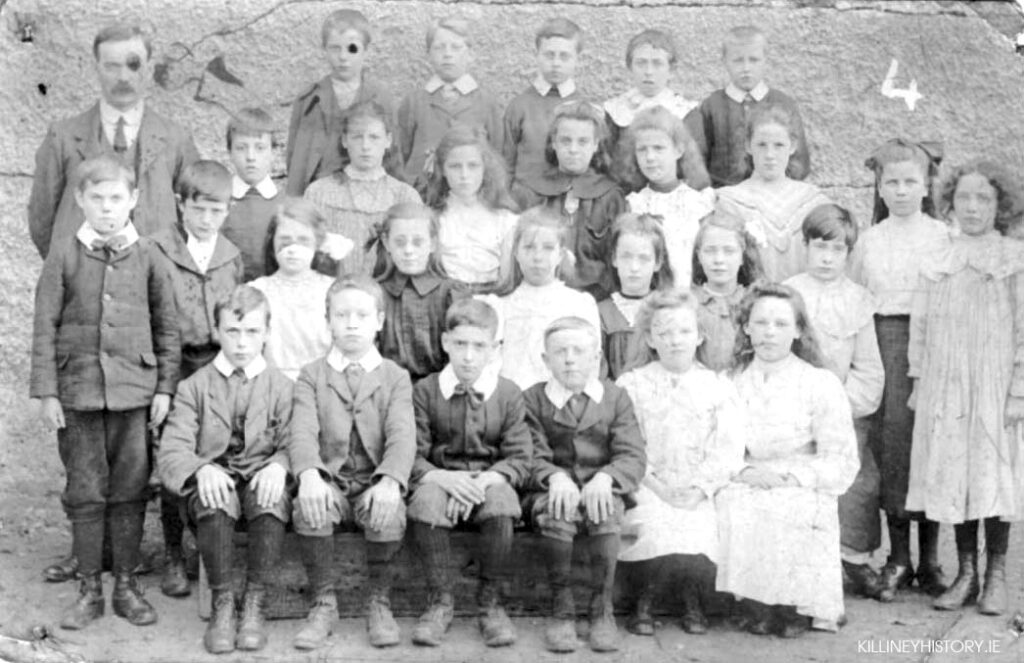
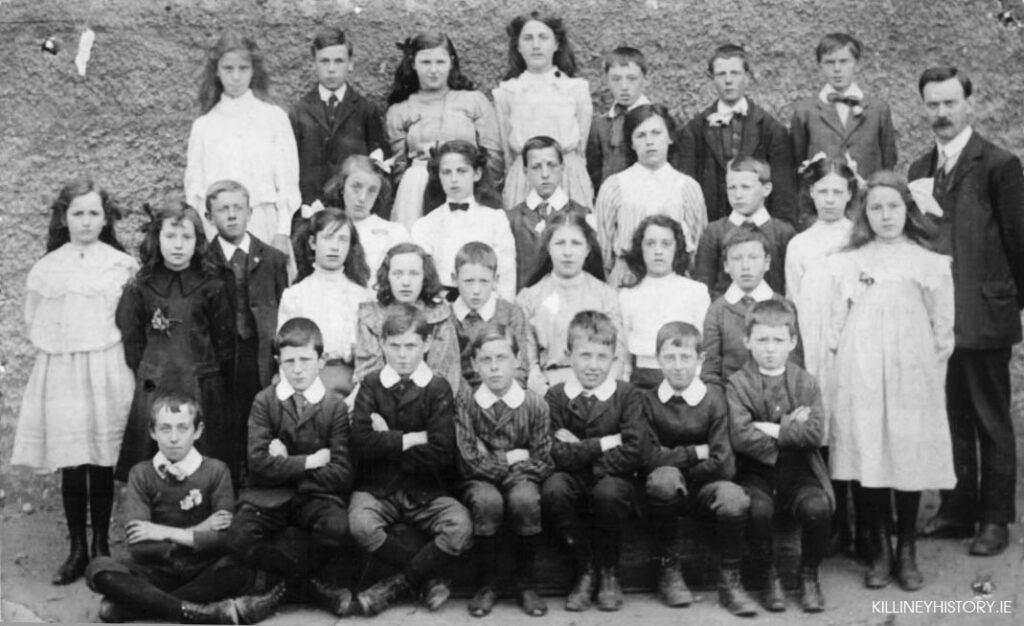
The Goodbody years c.1918-1947
It appears that A.E. Goodbody, the well known solicitor, was the successful purchaser of the house when it went to auction in 1918. At this time A.E. Goodbody was residing in nearby Sunnybank, now Arachon, which is located at the junction of Killiney Hill Road and Strathmore Road. From here he was directing improvement works being carried out at Montebello prior to moving in. The architect in charge here was William Mitchell & Sons who were involved in many building projects in the area at this time. A letter accepting the estimate of local builder, William Fanning, of £127-15-0 for the replacement of floor and joists, repairs to sashes, entrance door and roof slating etc was accepted and signed by A.E. Goodbody on 25th June 1918. Other works being carried out included an extension to the gate lodge as shown in the drawings below.
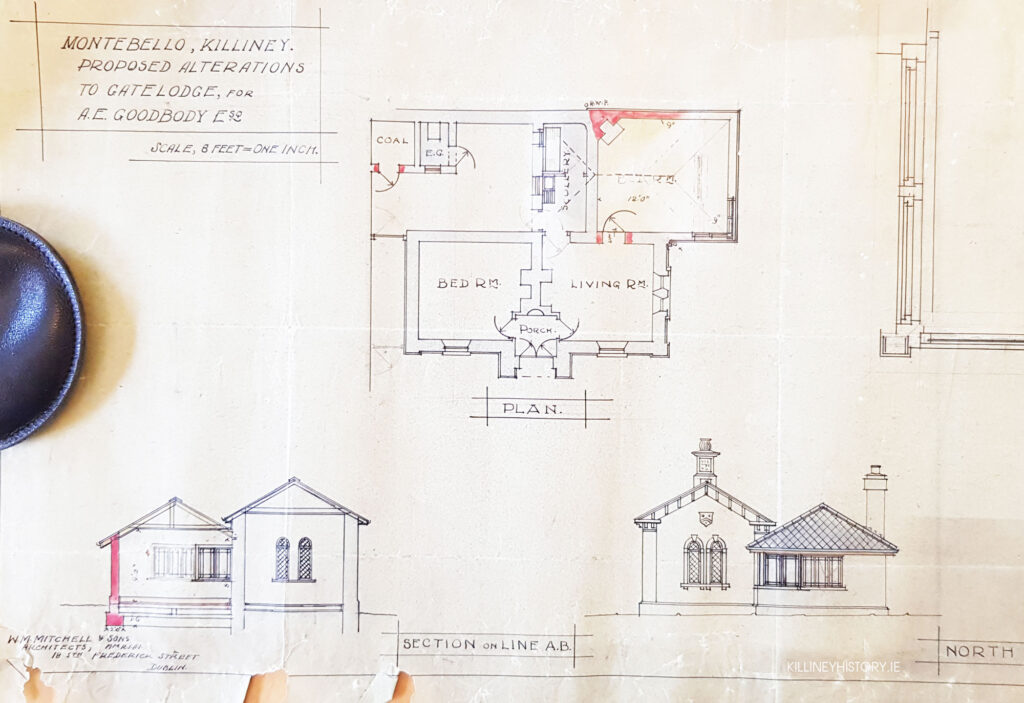
Dick and Anne Wilson era
Irish Times Property Section description by Madeleine Lyons in 2017
More recently it became the family home of Dick and Ann Wilson. With the Wilsons now deceased and the family dispersed, it’s an executor sale, though the house still seems very lived-in, and is filled with interesting mementos from a well-read and travelled life. Glasgow-born Wilson was an entrepreneur who initially made his fortune in the family pet food business. In the 1960s he invested a good portion of revenues from that business in complementary medicine, an area his family had become very interested in. Wilson went on to head up Nelson homeopathic remedies and in 1993 combined it with Bach Flower Remedies, producer of the hugely popular Bach Rescue Remedy. Dick and Ann Wilson originally lived in Belfast where Ann was a keen supporter of the arts. Friends included the painter TP Flanagan and the poet Seamus Heaney. An obituary in the Telegraph in 2006 credited Wilson with sustaining Belfast’s artistic life through the darkest days of the Troubles, and the couple’s passion for contemporary art followed them to their Killiney home. The same obituary refers to a poem penned by Heaney to commemorate Wilson’s 60th birthday. It began:
Dickie, at Montebello, years ago
You stood me with my back against a tree
The sap was rising, trust was high, and so
That sympathetic magic worked on me
The Wilsons purchased Montebello in the late 1960s in fairly poor repair and undertook a refurbishment that took several years to complete. What’s interesting is that the very fine joinery evident in the ornate woodwork throughout the property was completely stripped back to its bare wood finish. It makes for an unusual – and refreshing – first impression when so often fine houses are presented in gleaming painted hues. The protruding semicircular porch opens into a main hall dominated by wooden Grecian-style pillars, barley-sugar columns and bare wood floors. The staircase also features a rare, original wrought iron balustrade. The main drawing and diningroom receptions have lovely, bright dual aspects, with a fine marble fireplace at the heart of the drawingroom, while contrasting gilded cornicing and coving frames the entire ground floor. An elegant, well-appointed sunroom was added off the drawingroom in later years.
Occupants over the years
| Year | Occupant | Source |
| 1860 | Daniel Connolly | O’Dwyer |
| 1866/67 | Daniel Connolly | Thom’s (Killiney) |
| 1868 | Mrs. Connolly | Montobello Thom’s (Ballybrack) |
| 1868 | Joseph Kirkwood | Tony Plunkett |
| 1877-1884 | Major General, The Hon. C.D. Plunkett | Thom’s (Killiney) |
| 1888-92 | Plunkett, The Hon. Mrs. C.D. | Thom’s (Killiney) |
| 1894-1900 | Plunkett, Miss and The Misses Kirkwood | Thom’s (Killiney) |
| 1902 | James N. Richardson | Tony Plunkett |
| 1905-1907 | Kirkwood, The Misses | Thom’s (Killiney) |
| 1910-1911 | Carden, Richard George J.P. D.L. | Thom’s (Killiney) |
| 1912 | Kirkwood, Miss | Thom’s (Killiney) |
| 1917 | Vacant | Thom’s (Killiney) |
| 1918 | A.E. Goodbody | Irish Architectural Archive |
| 1920-1924 | A.E. Goodbody solicitor | Thom’s (Killiney) |
| 1926-1947 | Mrs. Goodbody | Thom’s (Killiney) |
| 1950 | Montebello & Montebello Cottage vacant | Thom’s (Killiney) |
| 1951 | His Excellency Michael McWhite | Monte Bella Thom’s (Killiney Hill Road) |
| 1952-1954 | Michael McWhite | Monte Belle Thom’s (Killiney Hill Road) |
| 1954 | Vacant | Montebello Cottage Thom’s (Killiney) |
| 1960 | Michael Harnett | Monte Bell Thom’s (Killiney Hill Road) |
| 1960 | Mrs. M. Pinamonte | Montebello Cottage Thom’s (Killiney) |
| 1975 | Robert Wilson | Montebello Thom’s (Killiney Hill Road) |
| 1975 | M. Connolly | Montebello Lodge Thom’s (Killiney Hill Road) |
As described by Peter Pearson (1998)
Montebello is a fine example of a mid-Victorian house, and was probably built for the Kirkwood family, who were landed gentry from County Roscommon. It was later occupied by A. E. Goodbody, solicitor, in the early 1920s. It was lavishly decorated with the best of joinery including Egypto-Greek style pillars and barley-sugar columns in the hall. A projecting semi-circular porch opens onto an elaborate flight of granite steps. The house, which has a noble aspect, is two-storeys-over-basement and has a pediment feature at parapet level. There is a small, octagonal summer house in the garden and, at the entrance to a winding avenue, a gate-lodge which bears a coat of arms depicting three scallop shells.
